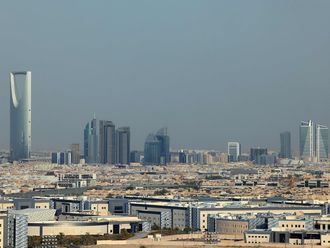
Hanoi: From the rural heartlands to traffic-choked cities, Vietnam Electricity Group is hard to miss. It builds apartments, runs a bank, oversees a stock brokerage, provides electrical power to millions of homes and employs 100,000 people.
Today, Vietnam’s sole retail power supplier, known as EVN, looks badly overextended, according to a senior industry official with knowledge of its business. It is the latest state behemoth to face scrutiny in the wake of debt blowouts that have shaken investor confidence and symbolised the decline of a country once tipped as Southeast Asia’s next economic star.
Some fear that the debt problem at EVN could dwarf that at shipbuilder Vinashin, whose default on a $600 million (Dh2.2 billion) loan damaged Vietnam’s reputation among foreign investors, although the monopoly has garnered far less international attention.
“I can tell you that its debt is far worse than Vinashin, maybe hundreds of trillions dong,” said the industry official with first-hand knowledge of EVN’s debts who asked not to be identified.
The arrest this week of high-profile tycoon Nguyen Duc Kien, the multi-millionaire founder of Vietnam’s fourth-most valuable bank, Asia Commercial Joint Stock Bank (ACB), adds to deepening fears of financial malaise in the Communist-run country of around 90 million people.
His detention inflamed worries about a sector strained by ties to debt-laden state companies, including many like EVN that have strayed well beyond core businesses as policymakers sought to build world-beating conglomerates in the mould of South Korea’s “chaebol”.
The central bank was forced to make a rare public assurance that funds in ACB were safe as depositors queued up to withdraw their money, while Vietnam’s main stock index fell around 9 per cent last week.
The near-collapse of Vinashin in 2010 and deep troubles at shipping line Vinalines this year, with combined debts of $6.5 billion, prompted a government vow to redouble reforms of state firms, which take up a third of the economy and crowd out private investment.
But the latest proposals announced in July appear to fall short of tackling the cronyism and muddled priorities that have allowed the 100 largest state-owned enterprises (SOEs) to run up debts of $50 billion - equal to nearly half Vietnam’s annual economic output in 2010.
The problems, say bankers and industry experts, extend well beyond Vinashin and Vinalines.
“They are the tip of the iceberg,” said David Koh, a Vietnam expert at the Institute of Southeast Asian Studies in Singapore.
A failure at EVN, for example, could have a far bigger impact on the overall economy by disrupting the cheap energy supply that is the lifeblood of the its manufacturing sector.
A report in the Saigon Times in May citing a State Audit body document said that EVN had debts of 240 trillion dong ($11.5 billion) at the end of 2010, nearly three times that of Vinashin at the same time.
The Tuoi Tre newspaper reported in December that EVN had losses from production of 8.4 trillion dong, more than 12 times the amount reported by EVN itself, according to the same report.
Those and other unflattering figures on SOEs were omitted from the State Audit’s official report sent to media in July.
EVN officials did not respond to several calls from Reuters seeking comment.
The true financial health of EVN, Vietnam’s fifth-largest company with revenues reported by state-run media at nearly $5 billion in 2011, is hard to know. The monopoly reported losses of 3.5 billion dong in 2011, but many economists doubt the accuracy of its financial announcements.
EVN announces some results to local media, but does not publish detailed financial accounts.
Despite its problems, Vietnam remains a manufacturing powerhouse, emerging over the past decade from the hangover of war to play a central role on Asia’s factory floor, producing everything from footwear to computer parts. An economy once built around carpet-bombed rice paddies now boasts gleaming shopping malls and imposing skyscrapers.
But in recent years its problems have overshadowed its promise - from spiralling inflation to red tape, creaking infrastructure and towering debts in an opaque financial system.
Credit growth has slowed sharply this year and the economy is growing at an annual pace of around 4 percent, down from nearly 7 percent in 2010.
The central bank said in July that bad loans in the banking system stood at 8.6 percent, nearly double its previous estimate and the highest ratio among major Southeast Asian countries, according to ratings agency Moody’s Investors Service.
The central bank cited “investigative results” from its inspectors for the big rise. State Bank of Vietnam Governor Nguyen Van Binh was quoted by state-run newspapers in June as saying the bad loan ratio was 10 percent, and some analysts believe the figure could be higher still.
“It’s hard to pinpoint which number it is that we should accept,” said Christian de Guzman, a senior analyst at Moody’s in Singapore who believes that more disruptive state-debt revelations are a possibility.
Most of Vietnam’s economic headaches can be traced back to mismanagement of SOEs.
A huge injection of cheap credit was channelled through the SOEs from 2009 as the government sought to cushion the effects of the global financial crisis. The SOEs went on a spree, expanding into areas where they had scant expertise.
The government has portrayed the two debt blowouts as anomalies caused by criminal mismanagement. Nine Vinashin executives were jailed this year for mismanaging state resources, including its former chairman Pham Thanh Binh, who got 20 years. Six Vinalines executives have been arrested and its former chairman is on the run.
“They attached personal interests to investment decisions ... there was corruption,” Nguyen Duc Kien, deputy head of the National Assembly’s economic committee, told Reuters.
Yet many observers say the type of mismanagement at Vinashin and Vinalines is endemic at SOEs, whose managers and board tend to be chosen based on political connections rather than business acumen. Prime Minister Nguyen Tan Dung personally championed Vinashin’s expansion and made a rare apology to lawmakers after its collapse, which prompted a series of humiliating credit downgrades for Vietnam.
But no one in the government has been brought to trial or punished over the firms’ downfall.
The arrested 48-year-old bank executive Kien, whose family is among the 30 wealthiest in Vietnam, could be a sign of growing tensions in the Communist leadership over economic policy.
“There’s quite a lot of dissatisfaction in the way the prime minister has helped these favoured sons, these state-owned enterprises,” said Steve Norris, a Vietnam analyst at Control Risks Group in Singapore.
The latest set of reforms announced last month appear bold at first glance. SOEs will have to withdraw from non-core businesses by 2015 and submit restructuring plans by the third quarter of the year. The government says it will subject the firms to “market mechanisms”, select managers more rigorously, give them more authority to fend off political interference, and set up a special body to oversee SOEs’ use of assets.
But Nguyen Duc Kien of the National Assembly’s economic committee acknowledged changes would take longer than 2-3 years to bear fruit.
Vietnam has been gradually reforming its SOE sector for years, cutting the number of companies to 1,300 from 6,000 since the turn of the century and turning 3,388 firms and their subsidiaries over to the private sector through so-called “equitisation”.
But the privatisation process has since slowed to a crawl.
Dao Van Hung lost his job at the helm of EVN this year after heavy losses at its telecom unit, shortly before the company and its debts were swallowed up by military-run telecoms rival Viettel. Hung was ushered back to Vietnam’s industry and trade ministry where he awaits a possible investigation.
Under Hung, EVN expanded into real estate, telecoms and banking even as the country suffered regular power cuts due to underinvestment in electricity generation.
The industry official who spoke to Reuters said the company’s accounting methods were a mystery even to many of those who work there, with no clarity over whether the losses were derived from its core business or from its new ventures.
A bloated, poorly qualified workforce was another big problem, he said.
Despite its other ill-fated business ventures, the bulk of EVN’s debts likely come from its inability to charge high enough prices to cover the costs of generation. Vietnam has among the cheapest power prices in Asia, but that has led to underinvestment and a shaky power supply that hurts business.
Hank Tomlinson, the chairman of the American Chamber of Commerce in Vietnam, said that some foreign-invested beverage firms in Vietnam run their operations on generators the whole time as it works out cheaper than facing supply disruptions.
“What businesses need is available and reliable power, not cheap power that requires generator sets running full time for back up,” Tomlinson said.
EVN has raised its electricity prices by 5 percent this year but a lack of transparency over the reasons for the hikes has generated suspicion among businesses at a time when there has been a surge in bankruptcies due to a tightening of credit.
“Businesses now suffer from so many fluctuations and economic losses, but so far what can we do? We just have to live with it,” said Cao Tien Vi, the chairman of Saigon Paper Corp, adding that EVN had not given warning of its latest price rise.












